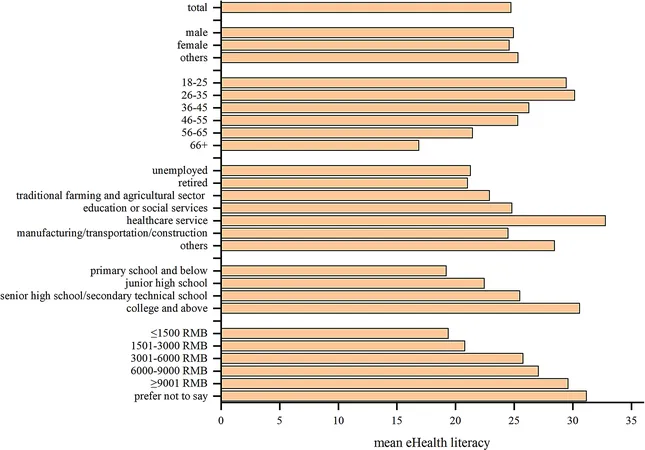
Unlocking the Secrets of eHealth Literacy in China: What a New Study Reveals!
2025-01-17
Author: Mei
Introduction
In today's digital age, eHealth literacy (eHL)—defined as the ability to effectively seek, find, understand, and appraise health information via information and communication technology (ICT)—is more crucial than ever. A recent cross-sectional study in China reveals that those with higher eHL engage in healthier behaviors, make better health decisions, stick to their medications, and enjoy higher quality of life. But what factors are influencing these literacy levels in the world's most populous nation?
Impact of Sociodemographic Factors
Studies suggest that gender, age, and education impact eHL rates, but findings are inconsistent. While some research points to higher eHL in younger, better-educated males, others show no significant relationships. This discrepancy may arise from varying populations and methodologies. Notably, a substantial portion of individuals, particularly those with low socioeconomic status, lack digital access, complicating the generalizability of past research findings.
Is the Digital Divide Widening?
Access to digital technology, such as smartphones, is crucial as patients increasingly rely on online resources for health information. Warning signs are evident: a lack of digital access correlates with poorer eHL. As China continues to grow its online health platforms—like Ali Health and WeChat—there's an urgent need for equitable digital health initiatives that address these discrepancies. Considering the digital divide, disadvantaged groups risk falling further behind in understanding their health conditions and accessing essential health services.
Adding to this concern, attitudes toward eHealth significantly influence eHL. A recent meta-analysis indicated that individuals harboring negative views about eHealth—stemming from doubts about its efficacy, privacy concerns, or disinterest—are less likely to engage effectively, thus impeding their literacy. Conversely, those with positive attitudes are more likely to embrace and utilize eHealth tools.
China's Unique Landscape for Study
With over 1.079 billion internet users and notable health apps gaining traction, China's robust digital landscape gives scholars more reason to focus on eHL. However, despite the rapid integration of technology in healthcare, knowledge gaps remain alarming. For instance, chronic lung diseases (CLD)—like chronic obstructive pulmonary disease (COPD) and asthma—present pressing health challenges, particularly due to underdiagnosis caused by limited public education on these conditions. Despite efforts to increase awareness, many educational campaigns fall short, compromising efforts to control and prevent CLD.
To delve deeper into the factors at play, the study in question examined eHealth literacy’s interplay with sociodemographic characteristics, digital access, attitudes towards eHealth, and knowledge of CLD among the Chinese general population. The study asked crucial questions, such as: What eHL levels exist across various sociodemographic groups? What associations can we uncover between these characteristics, digital access, and eHealth?
Research Insight: Addressing Disparities
Conducted in late 2023, the study collected 439 valid questionnaires from diverse participants across regions in China, revealing that while eHL averages hovered at 24.7 out of a possible 40, significant disparities existed among different groups. Younger individuals and those in healthcare professions showed notably higher eHL levels. However, a concerning proportion of older, low-income, and undereducated people reported lacking digital access altogether, highlighting inequality.
Moreover, participants demonstrated low CLD knowledge, with many unaware of environmental risk factors contributing to lung diseases. Recommendations urge targeted educational strategies that address these knowledge gaps and improve eHL through localized and accessible methods.
Recommendations and Future Directions
Now more than ever, it's vital to promote programs enhancing eHealth literacy, specifically tailored to cater to various demographic needs. By bridging gaps in digital literacy, policymakers can help mitigate health disparities. But the solutions don't stop there; collaborations with stakeholders will be essential in developing standardized frameworks for assessing and improving eHealth literacy across diverse populations.
This groundbreaking study emphasizes the importance of tackling the digital divide to empower individuals in making informed health choices. As China propels forward, understanding and nurturing eHealth literacy becomes a shared responsibility—one that can transform the nation's approach to health and wellness. Will China rise to the challenge? It’s a question that deserves attention as we collectively navigate the digital health revolution.



 Brasil (PT)
Brasil (PT)
 Canada (EN)
Canada (EN)
 Chile (ES)
Chile (ES)
 Česko (CS)
Česko (CS)
 대한민국 (KO)
대한민국 (KO)
 España (ES)
España (ES)
 France (FR)
France (FR)
 Hong Kong (EN)
Hong Kong (EN)
 Italia (IT)
Italia (IT)
 日本 (JA)
日本 (JA)
 Magyarország (HU)
Magyarország (HU)
 Norge (NO)
Norge (NO)
 Polska (PL)
Polska (PL)
 Schweiz (DE)
Schweiz (DE)
 Singapore (EN)
Singapore (EN)
 Sverige (SV)
Sverige (SV)
 Suomi (FI)
Suomi (FI)
 Türkiye (TR)
Türkiye (TR)
 الإمارات العربية المتحدة (AR)
الإمارات العربية المتحدة (AR)